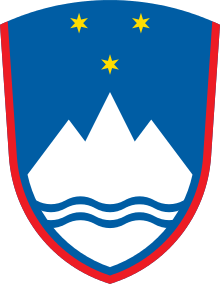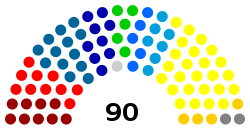National Assembly (Slovenia)
| National Assembly of the Republic of Slovenia Državni zbor Republike Slovenije | |
|---|---|
| 8th National Assembly | |
 | |
| Type | |
| Type |
Lower house of the Slovenian Parliament |
| Leadership | |
| Structure | |
| Seats | 90 |
 | |
Political groups |
Government (43)[1]
Opposition (36) |
| Elections | |
| Open list proportional representation with a 4% election threshold | |
Last election | 3 June 2018 |
Next election | no later than 5 June 2022 |
| Meeting place | |
| National Assembly Building, Ljubliana | |
| Website | |
| http://www.dz-rs.si/ | |
 |
|---|
| This article is part of a series on the politics and government of Slovenia |
|
Executive |
|
Legislature |
|
 Slovenia portal |
The National Assembly (Slovene: Državni zbor Republike Slovenije, pronounced [dəɾˈʒàːwni ˈzbɔ́ɾ ɾɛˈpúːblikɛ slɔˈʋèːnijɛ][2] or [-ˈzbɔ̀ːɾ-];[2] Slovene abbreviation DZ), is the general representative body of Slovenia. According to the Constitution of Slovenia and the Constitutional Court of Slovenia, it is the major part of the distinctively incompletely bicameral Slovenian Parliament, the legislative branch of the Republic of Slovenia.[3][4] It is unicameral. It has 90 members, elected for a four-year term. 88 members are elected using the party-list proportional representation system and the remaining two, using the Borda count, by the Hungarian and Italian-speaking ethnic minorities, who have an absolute veto in matters concerning their ethnic groups.
Currently, the 8th National Assembly is in session.
Legislative procedure
A bill can be submitted to the National Assembly by:
- the Government,
- MP,
- National Council or
- 5,000 voters.
Legislative procedure begins when the Speaker passes the bill to the MPs.
There are 3 possible legislative procedures:
- regular legislative procedure,
- shortened legislative procedure or
- urgent legislative procedure.
Bills are usually passed with the majority of the present MPs. If the Constitution demands a two thirds majority (laws regulating electoral systems, referendums and constitutional laws which amend the Constitution) then at least 60 MPs have to vote for the bill to pass it.
Regular legislative procedure
First reading
The first reading is completed with passing the bill to the MPs by the Speaker, unless 10 MPs request a session of the assembly within 15 days to discuss reasons why bill was submitted.
If the session is held, assembly must vote on the resolution if the bill is appropriate for a further procedure.
Speaker determines a working body that will discuss the bill in the furder procedure. Other bodies can also discuss the bill if there is such interest, however they cannot vote on it.
Second reading
During the second reading bill is first discussed by the working body that can amend the bill and make a report on the bill which is the basis for the plenary of assembly. Working body discusses and votes on each article of the bill. Assembly later votes and discusses only the articles that were amended during the session of the working body.
Assembly and working body can accept a resolution that the bill is not appropriate for a furder procedure if not such resolution was accepted during the first reading.
Third reading
In the third reading working body and assembly vote on the bill as a whole. If it is accepted the bill is sent to the President to sign it.
Shortened legislative procedure
During shortened legislative procedure there is no first reading and the second and third readings are held at the same session.
It can be applied for a bills that regulate minor matters, another law is abolished with the bill, if national laws have to be harmonised with Acquis communautaire or when bill regulates procedures before the Constitutional Court or Constitutional Court order changes of the laws.
Urgent legislative procedure
Bill can be passed under urgent procedure if it is important for the security or defence of the country, if it is addressing the consequences of natural disasters or it is proposed to prevent irreversible consequences for the country.
There is no first reading, the second and third readings are held at the same session, amendments to the bill can be given orally and timeline of the procedure is shorter.
Demand for new vote on the law
When bill is passed, National Council can demand that National Assembly votes again on the bill. Higher majority is needed to pass the bill in the new vote.
List of Speakers of the National Assembly
- Dejan Židan (SD): 23 August 2018 -
- Tina Heferle (acting) (LMŠ): 23 August 2018
- Matej Tonin (NSi): 22 June 2018 – 23 August 2018
- Milan Brglez (SMC): 1 August 2014 – 22 June 2018
- Janko Veber (SD): 27 February 2013 – 1 August 2014
- Jakob Presečnik (acting) (SLS): 28 January 2013 – 27 February 2013
- Gregor Virant (LGV/DL): 21 December 2011 – 28 January 2013
- Ljubo Germič (LDS): 2 September 2011 – 21 December 2011
- Pavel Gantar (Zares): 15 October 2008 – 2 September 2011
- France Cukjati (SDS): 22 October 2004 – 15 October 2008
- Feri Horvat (ZLSD): 12 July 2004 – 22 October 2004
- Borut Pahor (ZLSD): 10 November 2000 – 12 July 2004
- Janez Podobnik (SLS): 3 December 1996 – 10 November 2000
- Jožef Školč (LDS): 16 September 1994 – 3 December 1996
- Herman Rigelnik (LDS): 23 December 1992 – 16 September 1994
- France Bučar (SDZ): 17 May 1990 – 23 December 1992
Latest election
 | |||||
| Party/alliance | Votes | % | Seats | +/– | |
|---|---|---|---|---|---|
| Slovenian Democratic Party | 222,042 | 24.92 | 25 | +4 | |
| List of Marjan Šarec | 112,250 | 12.60 | 13 | New | |
| Social Democrats | 88,524 | 9.93 | 10 | +4 | |
| Modern Centre Party | 86,868 | 9.75 | 10 | –26 | |
| The Left | 83,108 | 9.33 | 9 | +3 | |
| New Slovenia - Christian Democrats | 63,792 | 7.16 | 7 | +2 | |
| Party of Alenka Bratušek | 45,492 | 5.11 | 5 | +1 | |
| Democratic Party of Pensioners of Slovenia | 43,889 | 4.93 | 5 | –5 | |
| Slovenian National Party | 37,182 | 4.17 | 4 | +4 | |
| Slovenian People's Party | 23,329 | 2.62 | 0 | 0 | |
| Pirate Party | 19,182 | 2.15 | 0 | 0 | |
| Good Country | 13,540 | 1.52 | 0 | –1 | |
| Andrej Čuš and Greens of Slovenia | 9,708 | 1.09 | 0 | –2 | |
| List of Journalist Bojan Požar | 7,835 | 0.88 | 0 | 0 | |
| For a Healthy Society | 5,548 | 0.62 | 0 | 0 | |
| United Slovenia | 5,287 | 0.59 | 0 | 0 | |
| United Left and Unity | 5,072 | 0.57 | 0 | –1 | |
| Movement Together Forward | 4,345 | 0.49 | 0 | 0 | |
| Save Slovenia from Elite and Tycoons | 3,672 | 0.41 | 0 | 0 | |
| Economic Active Party | 3,132 | 0.35 | 0 | 0 | |
| Solidarity - For a Fair Society! | 2.184, | 0.25 | 0 | 0 | |
| United Right | 2,141 | 0.24 | 0 | 0 | |
| Socialist Party of Slovenia | 1,551 | 0.17 | 0 | 0 | |
| Party of Slovenian People | 1,237 | 0.14 | 0 | 0 | |
| Forward Slovenia | 187 | 0.02 | 0 | 0 | |
| Italian and Hungarian national minorities | 2 | 0 | |||
| Invalid/blank votes | 10,357 | – | – | – | |
| Total | 901,454 | 100 | 90 | – | |
| Registered voters/turnout | 1,712,676 | 52.64 | – | – | |
| Source: Volitve | |||||
Elections of the representatives of national minorities
Italian national minority
| Candidate | Points | % | Notes | |
|---|---|---|---|---|
| Felice Žiža | 2,511 | 44.78 | Elected | |
| Mauricio Tremul | 2,095 | 37.36 | ||
| Bruno Orlando | 1,001 | 17.85 | ||
| Valid votes | 1,428 | 98.69 | ||
| Invalid/blank votes | 19 | 1.31 | ||
| Total | 1,447 | 100 | ||
| Source: Volitve | ||||
Hungarian national minority
| Candidate | Points | % | Notes | |
|---|---|---|---|---|
| Ferenc Horvath | 4,193 | 60.20 | Elected | |
| Gabriela Sobočan | 2,772 | 39.80 | ||
| Valid votes | 3,001 | 98.62 | ||
| Invalid/blank votes | 42 | 1.38 | ||
| Total | 3,043 | 100 | ||
| Source: Volitve | ||||
Mandates
- 1st National Assembly
- 2nd National Assembly
- 3rd National Assembly
- 4th National Assembly
- 5th National Assembly
- 6th National Assembly
- 7th National Assembly
- 8th National Assembly
Members
- List of members of the 1st National Assembly of the Republic of Slovenia
- List of members of the 2nd National Assembly of the Republic of Slovenia
- List of members of the 3rd National Assembly of the Republic of Slovenia
- List of members of the 4th National Assembly of the Republic of Slovenia
- List of members of the 5th National Assembly of the Republic of Slovenia
- List of members of the 6th National Assembly of the Republic of Slovenia
- List of members of the 7th National Assembly of the Republic of Slovenia
- List of members of the 8th National Assembly of the Republic of Slovenia
Notes
- ↑ Milan Brglez was re-elected on the Modern Centre Party list, then was expelled from the party due to disagreements with party officials. He now sits as an independent within the SD group
- ↑ Government parliamentary support
- ↑ Usually support Government
References
- ↑ "Slovenia's center-left coalition nominates Marjan Sarec for PM". Reuters. 8 August 2018. Retrieved 11 August 2018.
- 1 2 "Slovenski pravopis 2001: Državni zbor Republike Slovenije".
- ↑ "U-I-295/07-8" (in Slovenian). Constitutional Court of the Republic of Slovenia. 22 October 2008. Retrieved 16 December 2010.
- ↑ Lakota, Igor (2006). Sistem nepopolne dvodomnosti v slovenskem parlamentu (diplomska naloga) [The System of Incomplete Bicameralism in the Slovenian Parliament (diploma thesis)] (PDF) (in Slovenian). Faculty of Social Sciences, University of Ljubljana. p. 62.
Opinions differ, however the majority of domestic experts agree that the National Council may be regarded as the upper house, but the bicameralism is distinctively incomplete.
Further reading
- Toplak, Jurij. The parliamentary election in Slovenia, October 2004. Electoral Studies 25 (2006) 825-831.
External links
Coordinates: 46°03′06″N 14°30′05″E / 46.05167°N 14.50139°E